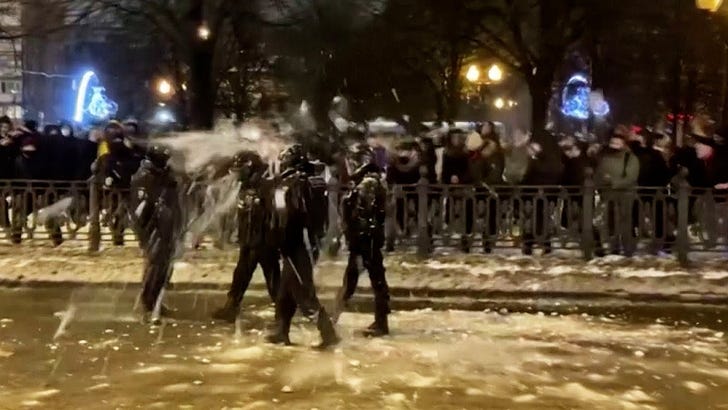On January 23, teenagers gathered in minus 20 degree Fahrenheit temperatures in Moscow to participate in a nation-wide protest demanding the release from jail of anti-corruption activist Alexei Navalny. As police closed in on them, the kids pelted them with snowballs.
Reports are that hundreds of children were arrested, and hundreds more adults, for participating in street protests across the country against Vladimir Putin and his predatory plutocracy. Many of the adults will be tortured and imprisoned. All of them will be forever tainted and intimidated. Even so, this weekend Russians will gather again, perhaps in greater numbers, like lambs heading into an autocratic abattoir.
They come because of Navalny. He is very special: Only once in a generation does a leader come along -- like Gandhi or Mandela or Martin Luther King Jr. -- who puts his life on the line against tyranny. Navalny, only 44, has been cheating death at the hands of the Kremlin for years. He has been jailed, partially blinded, assaulted, released from jail after mass protests in 2013, then poisoned this summer, and jailed again this month.
Navalny’s extraordinary story -- and Russian history — unfold this week on video captured by Navalny and his pro-democracy and anti-corruption followers. He has six million YouTube subscribers. Millions will watch online. Millions more should. This is martyrdom in real-time.
Putin has absolute power, but Navalny continues to expose corruption and organize elections and rallies. On August 20, he suddenly fell ill during a flight from Tomsk Siberia to Moscow, and the plane had to make an emergency landing. He was hospitalized, but his wife was able to get him released so he could be treated in Germany for poisoning. On September 2, the German government confirmed that evidence showed that Navalny was poisoned with a Novichok nerve agent, a banned substance used in chemical warfare — the same compound used to poison former Russian double-agent Sergei Skripal and his daughter in Britain in 2018.
Lucky to survive, he announced in October he would go back to Russia. Of this decision, esteemed writer Masha Gessen* of the New Yorker wrote: “He told me then that he would return to Russia because becoming an exile would give Putin exactly what he wanted: to be rid of him.” Russia tried to discourage this by announcing charges against him and by stating he would be arrested the minute he arrived.
Undaunted, Navalny recuperated and worked with an investigative team called Bellingcat. They confirmed his poisoners were members of Russia’s FSB (Federal Security Service), formerly the KGB. The poisoning, therefore, was an official state assassination attempt. The Kremlin denied this.
Navalny arrived in Moscow on January 17 and was arrested immediately, an event that was streamed live. Hours later, he appealed to Russians, on camera from inside the jail, to stage a mass protest against the regime because “they are afraid of you.”
Then two days later, his team released a bombshell, two-hour documentary narrated by Navalny called “Putin’s Palace”. It takes viewers on a drone tour of Putin’s estate on the Black Sea which he claims is 39 times’ bigger than Monaco. The film includes computerized mock-ups of its massive interior, based on information from contractors, and includes an underground hockey rink, theater, and ballroom. It features a drone tour of the vast grounds, its port, church, vineyards, casino, coastine, and helipad. Navalny claims that the palace cost $1.3 billion and was paid for with proceeds from a gigantic graft scheme. It has been viewed by 96 million people around the world, including an audience within Russia that is bigger than watch Russian state television.
In response, Kremlin spokesman Dmitry Peskov said the palace existed, but doesn’t belong to Putin — a denial which, in the minds of Russians and those of us who have immersed ourselves in Russian political intrigue, confirms the exact opposite.
"It is the most secretive and well-guarded facility in Russia, without exaggeration," Navalny narrates. "This isn't a country house, it’s not a cottage, it's not a residence — it's an entire city, or rather a kingdom. It’s like a separate state inside of Russia. And in this state, there is a single and irreplaceable czar. Putin."
Navalny now awaits trial on February 2 and has called upon Russians to stage another protest this weekend. This perilous confrontation represents the first major foreign policy challenge, and a defining moment, for President Joe Biden. The administration’s response has been firm: A request by security officials to release Navalny and his jailed followers, and Biden’s condemnation in public, and in his first call with Putin, of Russia’s aggressions in the region, cyberattacks against America, and Navalny’s poisoning. By contrast, former President Donald Trump never publicly mentioned the poisoning at all.
Irrespective of what happens in Russia and at Navalny’s trial, Washington and its European allies are preparing to unleash severe sanctions against Russia, its leaders, and possibly Putin’s cronies, a specter that has made the rouble wobble this week.
Nonetheless, Navalny and his followers remain in grave danger. The Russian “street” is still no match for Putin’s army of helmeted riot police. This means that all the world can do is bear witness. And must. Navalny’s cause is just and his selflessness is extraordinary. It is noble … so suicidal, so Russian, so magnificent.
* I highly recommend reading Masha Gessen’s articles and her books, most recently The Man Without A Face: The Unlikely Rise of Vladimir Putin, Surviving Autocracy, The Future is History: How Totalitarianism Reclaimed Russia, and Words Will Break Cement: The Passion of Pussy Riot.
My newsletters will arrive in your inbox Monday and Thursday mornings, sometimes more often.



